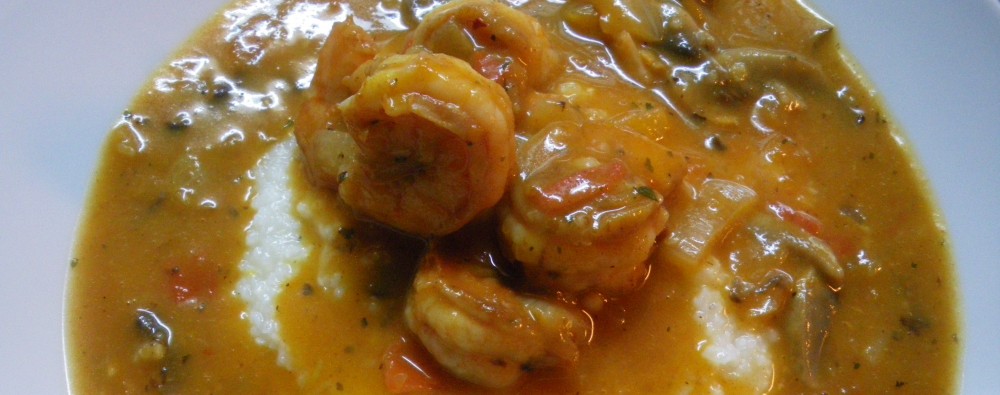I love that line from the movie My Cousin Vinny just as much as the look on the cooks face when Vinny checks out his breakfast special and says: Sure I heard of grits, I’ve just actually never seen a grit before… I couldn’t help thinking of that scene as I was stirring my grits for a good ol’ southern breakfast yesterday. The fact that the movie played on TV last week made it even funnier. (Ok, this wasn’t yesterday, it was months ago … I just never got around to posting this!)
So, how does someone who lives in Brussels even get their hands on grits? Don’t even try, it’s impossible… it took a trip over to the US to get my hands on them, but it certainly was worth it! I’d been wanting to make the popular shrimp and grits classic without having to substitute mashed potatoes for grits, so on my recent trip stateside I loaded up on a few boxes of grits. I’m not knocking my Idahoan mashed potatoes, but it definitely takes half the grit fun out of the classic (I think even my shrimp were complaining).
I actually wanted to buy the cheesy grits kind of grits that I had at a restaurant once as part of a delectable meal, however, after checking out the label and seeing the only difference between cheesy and original was processed cheese, I figured I could stir in some real cheese when I got them home. After a quick 3-4 minute wait for my grits to be done, I stirred in a hunk of feta cheese. Yes, yes, I know “no self respecting southerner uses instant grits”, but luckily I’m not a southerner, so I bear no shame in my instant grits!
Wow, were they ever good. Why haven’t grits for breakfast caught on around the world, I ask?
Grits are a popular breakfast food all over the southern US, and it’s easy to understand why, but I have to say, they are even more delicious when eaten as the shrimp and grits main entrée version.
As a newspaper in Charleston once put it: “A man full of grits is a man full of peace”.
Here’s my modified Charleston Shrimp and Grits Recipe
Ingredients
- About 700 g shrimp, peeled and deveined
- Juice of 1 lemon
- Tabasco or other hot pepper sauce
- 1 tsp salt (adjust to taste)
- 2- 3 tbsp olive oil
- 1 large onion, finely chopped
- 1/4 cup finely chopped green bell pepper (I left this out)
- 1-2 garlic cloves, minced
- 1 ripe tomato, finely chopped
- 3-4 thinkly slice white mushrooms
- 1/2 cup thinly sliced scallions
- 2 tablespoons unbleached all-purpose flour
- 1/2 cup white wine (or use stock if preferred)
- 1/2 cup chicken stock
- 1 to 2 tablespoons unsalted butter (stirred into the grits, or you can add it to the oil when sautéeing the shrimp)
Grits – I used Quaker original instant grits, followed package directions and then stirred in feta cheese until I was happy with the taste of it.
Directions
- Combine the shrimp with the lemon juice and a few splashes of hot pepper sauce, set aside for 5 -10 minutes before beginning
- Add oil to a heavy bottomed pot/pan and sauté the shrimp gently until lightly pink, remove and keep aside
- In same pan, sauté the onion and garlic until soft
- Add the green pepper, mushrooms and tomato and sauté until soft, about 5 minutes
- Add the scallions, sprinkle the flour over the mixture, and continue sautéeing for a few minutes longer
- Stir in the wine & let some of the alcohol evaporate off while stiring
- Add the stock and salt and cook for 5 minutes longer or until a thickish gravy forms
- Remove from the heat, add the shrimp back in
- Cook grits according to package directions
- Serve quickly, mounding the grits in large shallow bowls or on plates and covering them with shrimp and sauce
Makes about 4 tasty servings. Enjoy!
If you can’t get your hands on grits, just pour them over a serving of cheesy, fluffy mashed potatoes!



































